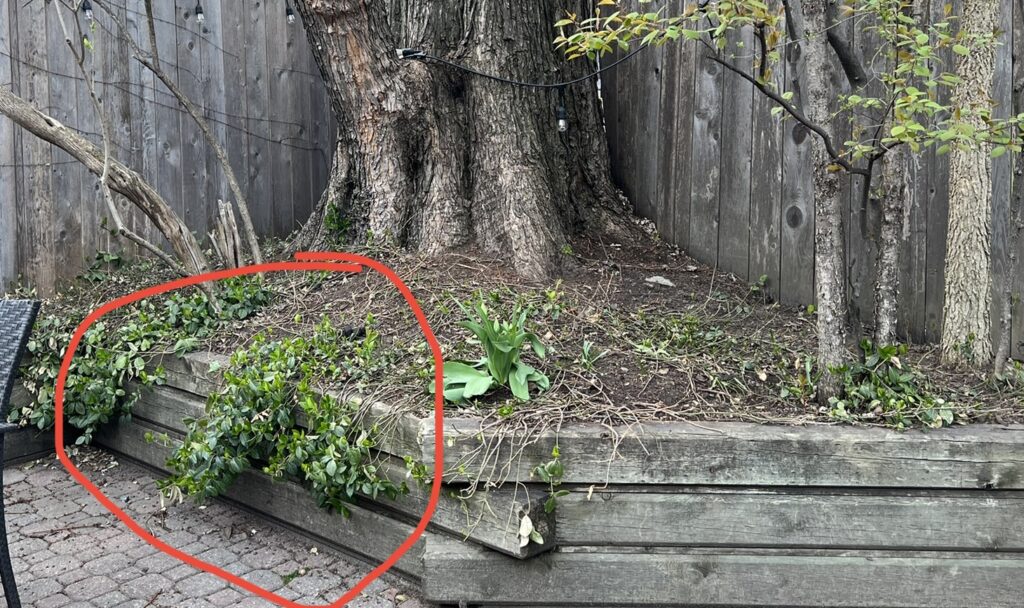
Hello, I live in Toronto and I have a big maple tree in my backyard — the tree bed used to be mostly full with euonymus fortunei. However, this year, after the winter, a lot of it seems to be gone (remainder is circled in red). How do I thicken that and make it spread (as it once was)? Is it all dead and have to remove it and replant?
Hi – thanks for your question about plants diminishing under a maple tree.
You haven’t identified the maple variety. Regardless, all maples have a root system that is close to the soil surface, so they snap up most of the nutrients and water. Norway maples (an invasive species) are particularly problematic because of dense foliage which blocks light. Also, fallen leaves could create a thick mat, suppressing growth of other plants. As your maple (no matter what kind) continues to mature, plants will likewise continually struggle to thrive.
If you have a Norway maple or a silver maple (a weak tree), consider replacing it.
There ARE shallow-rooted perennials and annuals that can grow under the dry shade of a maple. See below links to previous questions on our website about suitable plants.
Understandably, you feel disappointed that a formerly healthy plant is languishing. However, you may not realize that wintercreeper (Euonymus fortunei) is invasive in parts of the U.S. – see below link for more information. Perhaps its decline has positive aspects, providing an opportunity for a new and better garden bed.
I suggest removing the remaining euonymus and replacing it with more desirable plants. Southern Ontario natives for dry shade will provide nectar, food and shelter for bees, butterflies and other pollinators, beneficial insects and wildlife. Or use a mix of native and non-native perennials, plus annuals for season-long colour. Try to select pollinator and wildlife friendlies. Whatever you decide, aim for diversity and interest from early spring to late fall and through the winter. A monoculture of just one or two plants reduces insect and other wildlife diversity that is so important for gardens to thrive.
After pulling out the euonymus, spread a 1-2″ layer of compost before replanting to enrich soil and help hold moisture, but don’t overdo it as too much compost can be detrimental (1-2″ per year is a good amount). Planting some dense groundcovers avoids spending money and effort on repeated mulching – but at least for the first year, a 2″ layer of mulch will reduce weeds and watering. Include spring-blooming bulbs and ephemeral plants if possible; they get enough sunlight to thrive before trees leaf out, and later provide green mulch as the foliage dies down and other plants emerge and grow to take their place. The excitement and health benefits of early spring green and other garden colour after a long winter cannot be beat.
Another option is containers under the tree – again, plants that flourish in dry shade would be best, but if you would like colourful blooms, you can use lightweight pots on wheels (e.g. fibreglass) that can be moved temporarily into more sun every week or so. However, since you liked the euonymus, perhaps you would be happy with plants that are mostly about the foliage. If chosen thoughtfully, foliage plants can provide impressive season-long colour, texture, contrast and interest.
Consider pruning the maple so that more light gets to the understory plants – this is best done by a professional arborist; you can find one through Landscape Ontario, whose website I’ve linked below.
Finally, it seems that the ground is sloping steeply away from the tree trunk- so any rain or other water may be running off and not soaking into the soil. Perhaps increase the height of the raised bed so that it is flush with the base of the tree, and add some soil and compost. However, do not pile soil or mulch against the trunk of the tree, as this could cause problems with air circulation and disease. Instead, create a well that slopes downwards toward the tree trunk (see Planting a Tree for Life below).
Good luck; I hope you are able to get a new plant palette to thrive under your maple.
Native plant suggestions for sun and shade
Native Plants for Shade: A Toronto Master Gardeners Guide – Toronto Master Gardeners
Drought Tolerant Perennials: A Toronto Master Gardeners Guide – Toronto Master Gardeners
Perennials for Shade and Part Shade: A Toronto Master Gardeners Guide – Toronto Master Gardeners
Growing Under a Norway Maple – Toronto Master Gardeners
Norway Maple – Toronto Master Gardeners
Annuals under maple – Toronto Master Gardeners
Euonymus fortunei, Winter Creeper – Invasive Species (extension.org)
Native Plant Alternatives to Euonymus fortunei (Wintercreeper) (gardenia.net)
Find a Pro – Landscape Ontario
Planting a Tree for Life: A Toronto Master Gardeners Guide – Toronto Master Gardeners
May 5-2022

